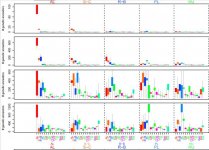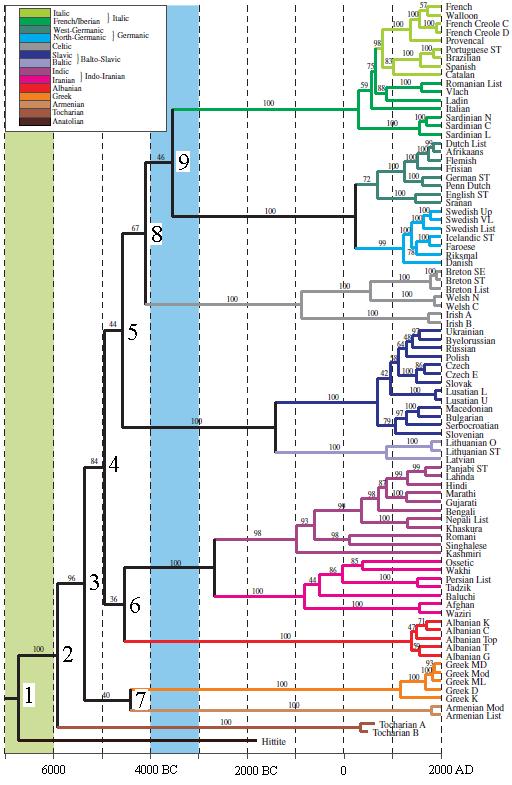That was just a reply to
Garrick and to show which European populations have more components % of near eastern.
Because he was the one saying that
Albanians came from Caucus area not even
1,000 years ago, and apparently said that he didn't know if "slavs " or Albanians came as the recent newcomers....where the studies show the different.
Garrick
Proto Albanian originated from area Caucasus, today’s eastern Turkey and northern Iran. And it is possible that population who spoke proto Albanian moved over land in the region around Black sea to the Moldavia (Southern Ukraine/Romania). And this population mixed in with E-V13 carriers who were numerous in the area where these two populations merged (maybe in this area E-V13 is numerous and today).
He even said that
Garrick
Albanian has same root as Indic languages (for example Kashmiri) and Iranian languages (for example Baluchi), which can means, if they’re right, that proto Albanian was more to the east far from the Armenian.
And this was actually from the study HE HIMSELF sourced (completely misrepresented)
This is the video done by business insider from the same source (Albanian came from Baluchi?)
<b style="color: rgb(51, 51, 51); text-align: justify; background-color: rgb(250, 250, 250);"><span style="font-family: Tahoma;"><em><font color="#333333">
Russell D. Gray & Quentin D. Atkinson, University of Auckland, New Zealand
https://www.webdepot.umontreal.ca/Usagers/tuitekj/MonDepotPublic/cours/IE/GrayAtkinson.pdf
Then he comes into
Albanian and Berber language similarity
http://www.eupedia.com/forum/thread...anians-E-haplogroup-and-linguistic-similarity
All this makes me think one of those individuals whom for whatever reason want to show
Albanian as foreign as possible. No matter what (facts or no facts) and by consistently attacking and even supposing that Albanians came with Ottomans as they picked them as slaves from Caucus. Believe it or not some Countries still get educated by this in their history books.
I noted that of course all the european populations have a mixture with near eastern component and EN farmers, however
Sardinians Albanians and Greeks have the lowest % (for near eastern component) as their descend
more from Early European farmers, and if you read the older posts we were talking only for
Early Neolithic to mid Neolithic because before 10,000 ycp Early European farmers either came from Africa or near east (so probably from near eastern farmers)
Of course all the Europeans have some descend from EEF, i was only noting that (as per study)
Sardinians Albanians and Greeks have the
highest % as their descend more from
Early European farmers, and if you read the older posts we were talking only for
Early Neolithic to mid Neolithic because before 10,000 ycp
Early European farmers either came from Africa or near east (probably from near eastern farmers).
Recent discoveries in Europe, such as Cyprus and mainland Greece has shown that farming started early in south east Europe. In Franchthi Cavein Greece there are no certain gathering of plant foods attested before c. 11,000 bc, although large numbers of seeds of the Boraginaceae family may come from plants gathered to furnish soft bedding or for the dye which their roots may have supplied. First appearing at c. 11,000bc are lentils, vetch, pistachios, and almonds. Then c. 10,500bc appear a few very rare seeds of wild oats and wild barley. Neither wild oats nor wild barley become at all common until c. 7000bc[19][20]in Cyprus. The oldest agricultural settlement ever found on a Mediterranean island has been discovered in Klimonas. between 9100 and 8600 bc
Anthropological and archaeological evidence from sites across Southwest Asia and North Africa indicate use of wild grain (e.g., from the c. 20,000b c site of Ohalo II in Israel, many Natufian sites in the Levant and from sites along the Nile in the 10th millennium bc).
It was not until after 9500 bc that the eight so-called founder crops of agriculture appear: first emmer and einkorn wheat, then hulled barley, peas,lentils,bitter vetch, chick peas and flax. These eight crops occur more or less simultaneously on Pre-Pottery Neolithic B (PPNB) sites in the Levant
By 7000 bc, sowing and harvesting reached Mesopotamia.....http://en.wikipedia.org/wiki/History_of_agriculture
So that might mean that by 10,000 ybp there was already farming in the far south east Balkans that came from north east Africa and the far south west Levant.
It looks like the peak was south east Africa (could be M-78 Peak) end the far south west Levant (Ohalo) which at the same time might have spread in one direction at
Crete and then Peloponnese 10,000 BC (reaching south East Europe without going across through Levant and Anatolia) and the other group spread through Levant Syria and reached
Mesopotamia by 7,000 BC.





